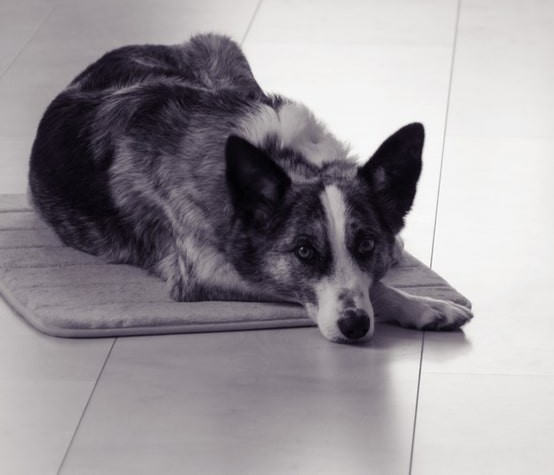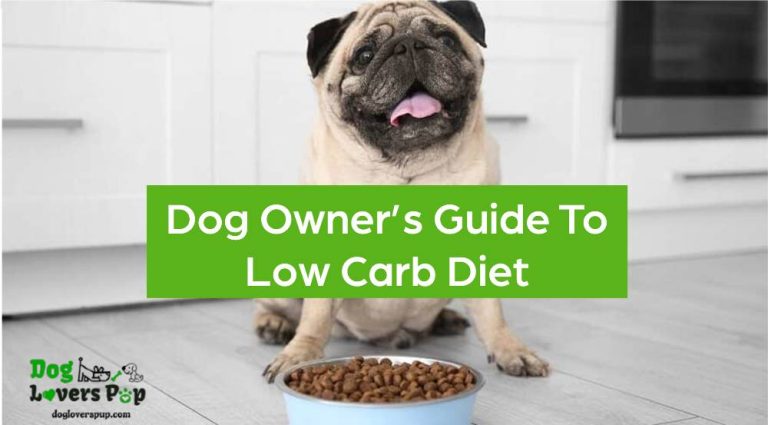How to Transition Your Dog to a New Food
- Last updated on April 6, 2023
- By: Caroline Stowe
It can be difficult to transition your dog from one food to another due to a number of reasons, such as dietary needs or even a change in the budget.
No matter what the reason is for the switch, it’s important that you do so safely and properly without putting your furry friend at risk.
This guide will provide you with helpful tips and advice to make the transition from one food to another as easy and stress-free as possible.

Recognizing the Signs Your Dog Needs a Diet Change
Your dog’s diet is an important part of their overall health, so it’s important that you know when they need a change in their food.
Here are a few signs that your pup may need more, or less, of certain nutrients in their diet:
Weight Gain
If you’ve noticed your pup has been packing on some extra pounds, this could be an indicator that they need to switch up their current diet.
Dogs require specific nutrients and calories to maintain healthy weight levels, so if yours isn’t getting enough of either one, it could lead to excessive weight gain.
Poor Skin & Coat Health
A poor diet can also lead to issues with skin and coat health. You may have noticed your pup scratching more than usual or patches of dryness or discoloration in their fur.
This could mean they’re not getting the right vitamins and minerals they need from their current food source, so it might be time for a new one.
Lack of Energy

Dogs need plenty of energy to stay active throughout the day, but if yours seems like he’s lacking it, this is another indication that something isn’t quite right with his current diet plan.
Look into switching up their food to something with higher quality ingredients that provide more nutrition for them.
Recurring Ear Infections
Just like humans, dogs can suffer from ear infections due to poor diets as well.
If your pup has been dealing with chronic ear infections recently, you may want to consider making an adjustment in what he is eating as this could be a sign that his body isn’t getting the proper nutrition it needs to fight off bacteria and other germs that cause these issues in the first place.
Vomiting & Diarrhea
If your dog has been experiencing bouts of vomiting and diarrhea recently, this could also indicate they are not getting enough nutrients from their food source or that they are consuming something toxic or allergenic that doesn’t agree with them (i.e moldy food).
In either case, you should consider switching up their diet as soon as possible to prevent further problems from occurring down the line.
Bad Breath & Gums
Just like humans need dental care for optimal oral health, so do dogs!
If you notice your pup’s breath smells particularly bad or if their gums appear redder than usual, this could be another sign they are not receiving adequate nutrition from their current food source.
You should probably switch things up soon before any serious damage occurs internally in the body (i.e liver disease).
Increased Thirst & Urination
Excessive thirst and urination can often be caused by diabetes which can stem from poor diets as well as genetics.
However, if neither is present then there may still be something wrong with what they’re eating on a daily basis – especially if these symptoms occur often or suddenly out of nowhere without any explanation whatsoever!
Switching over to a healthier option may help reduce these occurrences significantly over time so definitely keep an eye out for any changes here too!
Constipation/Diarrhea Issues
These two digestive-related issues can often go hand-in-hand depending on what type of diet your pup is currently consuming.
Too much fiber or not enough moisture content can both contribute towards constipation while too much fat content plus lack of fiber intake will usually result in bouts of diarrhea instead!
Adjusting portion sizes accordingly along with introducing more moist foods into meals should help alleviate these problems quickly without needing medications or supplements later down the road!
Picky Eating Habits/Lack Of Appetite
Dogs typically love eating.
However if yours has become increasingly picky about what he consumes – especially when compared against other members within the same breed/age group – then chances are good he may need some dietary adjustments due to certain allergies/sensitivities present within environment currently being exposed too on regular basis (i.,e pollen counts outside, etc.).
Consulting veterinarians should help clarify which causes behind pickiness may exist plus recommend alternative options better suited towards eliminating those specific sensitivities altogether!
Unusual Stool Appearance/Odor
The last indicator suggesting potential dietary issues comes directly from examining stools produced after each mealtime – i.e does its appearance seem unusual compared to normal production output? Does its odor seem overly pungent regardless of how fresh feces appears externally?
Any sudden changes here warrant immediate attention since underlying causes behind strange stool production will ultimately depend upon the exact nature/type of ingredient being consumed during the momentary period before noticing oddities present afterward!
Understanding Different Types of Food and Their Benefits
Different types of canine food provide different benefits for your pup. It’s important to understand the differences between them so that you can choose a food that best suits the needs of your furry friend. Here’s a quick breakdown of different types of pet food:
Kibble/Dry Dog Food
Kibble is probably the most popular type of dog food due to its convenience, affordability, and long shelf life. It also contains the necessary vitamins and minerals to keep your pup healthy.
Many kibbles are designed with specific breeds in mind, making them even more beneficial for pet owners looking for tailored nutrition options for their furry friends.

Canned/Wet Dog Food
Canned or wet dog foods are usually high in water content, making them more palatable than dry kibble. They typically come with more flavor variety than kibble as well, so picky eaters may find them more appealing.
Wet foods are also great for puppies because they often contain higher amounts of proteins and fats needed for growth and development.
Raw Diet Foods
Raw diets have become increasingly popular in recent years because some pet owners believe it is a healthier option for their dogs compared to processed foods.
These diets consist mostly of raw meat, organs, bones, fruits, and vegetables – items that canines would naturally eat in the wild if given the opportunity.
While there has been debate about whether or not a raw diet is actually better than processed foods, proponents argue that raw diets provide essential nutrition without added chemicals or preservatives found in processed foods.
Freeze-Dried Foods
Freeze-dried foods have seen an increase in popularity due to their convenience as well as their health benefits compared to canned or wet foods.
Freeze-dried meals tend to retain more nutrients since they’re not cooked like other types of dog food; however, these meals can be quite expensive due to the labor-intensive process required to make them.
Additionally, freeze-dried foods don’t contain any added fillers like grains or corn which can be beneficial for dogs with allergies or sensitivities.
How to Transition Your Dog to New Food Safely
Making the switch from one food to another can be stressful for both you and your pet. Here are some tips to help make the transition as smooth as possible:
Introduce the New Food Slowly
This is probably the most important tip when it comes to making a dietary change with your pet. Rather than switching cold turkey, start by mixing the new food in with their existing one.
Mix small amounts of the new food in with their existing food over a few days then gradually increase the ratio until you’ve completely replaced their old diet with the new one.
This will give them time to adjust and reduce any potential gastrointestinal issues.
Make Sure They Get Enough Water
It’s important to make sure your pup is getting enough water when transitioning to a new diet. If they don’t drink enough, it can lead to dehydration and other health problems.
Make sure there’s always fresh water available for them throughout the transition process and beyond.
Monitor Their Progress
Once you start introducing the new food into their diet, be sure to monitor how they’re doing with it – look out for any changes in their behavior or health that could indicate that something isn’t quite right with the new food or how much they’re eating (or not eating).
This will help you determine if there are any issues that need addressing sooner rather than later!
Monitor Their Appetite
When transitioning your dog’s food, pay attention to how much they’re eating and if they seem interested in it or not.If they’re not eating as much or seem uninterested in the new food, try adding something tasty like cooked eggs or canned fish into their kibble as an extra treat.
Look Out For Any Changes In Their Behavior
Keep an eye out for any changes in their behavior during the transition process such as vomiting, diarrhea, constipation, or excessive gas production which could indicate digestive issues due to incompatible foods being eaten together or allergies/intolerances developing suddenly when changing diets too quickly.
If these occur, stop immediately and contact your vet for advice on how best to proceed with introducing the new food safely again in smaller amounts over a longer period of time if necessary.
Check for signs of restlessness too. Sometimes dogs can struggle to adjust to different flavors or textures found in some brands of kibble so if this is happening then it might be worth trying something else instead.
Watch Their Weight
During transitions, pay close attention to your pup’s weight too; sudden changes could indicate either overeating (which could be caused by boredom) or under-eating (due to lack of appetite).

Keeping an eye on this will help you ensure that you are providing them with all of the nutrients they need without going overboard in terms of calorie intake.
Consider Supplements
Depending on what type of food you decide on, there may be some essential vitamins and minerals missing from it which can affect overall health and well-being so consider adding dog vitamins and supplements into your routine if necessary just before making any major dietary changes.
Seek Professional Advice
Before making any major dietary changes, seek professional advice from a vet or nutritionist is always an option!
They will be able to provide personalized recommendations based on your pup’s individual needs – such as breed, age, activity level etc, and can answer any questions you may have along the way.
Choose Quality Ingredients
When selecting a brand/type of kibble, read labels carefully; look out for things like high levels of grain content (which can lead to allergies ), preservatives (which can cause health issues ), etc
Don’t Switch Too Quickly
Avoid abruptly switching your pup’s food; this could cause digestive upset and may even lead to malnutrition if they don’t get all of the nutrients they need from their new diet right away.
Instead, do a slow transition over several days so that their bodies can slowly adjust without any problems or discomfort.
Be Patient
Making big changes takes time; have patience when transitioning your pup onto something new and remember that every dog is different so it may take longer than expected for some but this doesn’t mean giving up!
Just keep at it until you find something that works best for both you and your furry friend!
Learn more by clicking the link below.
Conclusion
Switching dog foods can be a daunting task but following these tips can make it much more manageable – both for yourself and your furry friend!
Make sure to take things slow so as not to overwhelm them and always seek professional advice if needed; remember – no one knows what’s best for them better than a vet or nutritionist!
With these tips in hand, hopefully, both you and your pup can find a happy balance between old favorites and exciting new meals ahead!
-
Author: Caroline Stowe
- Updated on April 6, 2023
Disclaimer: This article doesn’t intend to replace professional veterinary advice, nor should it be used as a substitute for veterinary services, diagnosis, or treatment. The content on this website, including information and opinions expressed herein, are intended for general informational purposes only. In case you have concerns or questions regarding your dog’s health and diet requirements, please consult your veterinarian before doing anything that might affect it.
DogPetGuide.com and the writer are not responsible or liable for any damage, liability, costs, or claims arising from any possible consequences of the reader’s action after reading this article.




